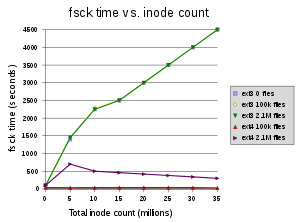find more information on ext2/3/4 filesystem
2013-09-20
224 words
2 mins read

In my previous post on check filesystem regurlarly, I mentioned tune2fs. That tool give quite a lot of information. But just in case, you did not find what you are looking for in the output, then you can get much more information on these partitions with the dumpe2fs command.
dumpe2fs
You do really get a lot of information, and here are some of them:
Filesystem volume name
Last mounted on
Filesystem UUID
Filesystem magic number
Filesystem revision #
Filesystem features
Filesystem flags
Default mount options
Filesystem state
Errors behavior
Filesystem OS type
Inode count
Block count
Reserved block count
Free blocks
Free inodes
First block
Block size
Fragment size
Reserved GDT blocks
Blocks per group
Fragments per group
Inodes per group
Inode blocks per group
Flex block group size
Filesystem created
Last mount time
Last write time
Mount count
Maximum mount count
Last checked
Check interval
Next check after
Lifetime writes
Reserved blocks uid
Reserved blocks gid
First inode
Inode size
Required extra isize
Desired extra isize
Journal inode
Default directory hash
Directory Hash Seed
Journal backup
Journal features
Journal size
Journal length
Journal sequence
Journal start
and much more……
Related articles
Related Articles:
- 2013/09/05 Set some disk params to be safe
- 2012/11/27 Allow incoming/outgoing ports on iptables
- 2012/02/09 Tora installation on Fedora 16 with rpm
- 2009/12/24 EncFS – Simple article to use Encrypted filesystem in Linux
- 2013/05/10 Fedora – Ramdisk creation

Authored By Amit Agarwal
Amit Agarwal, Linux and Photography are my hobbies.Creative Commons Attribution 4.0 International License.



